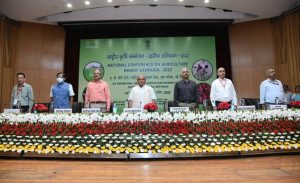The National Conference On Agriculture For Kharif Campaign 2022-23

The National Conference on Agriculture for Kharif Campaign 2022-23 has been inaugurated by Union Agriculture Minister, Narendra Singh Tomar at the NASC Complex, New Delhi. As per the 2nd Advance Estimates (2021-22), the country’s total production of foodgrains is estimated at 3160 lakh tonnes which is an all-time record.
- The production of oilseeds and pulses will be 371.5 and 269.5 lakh tonnes, respectively.
- As per the 3rd advanced estimates, during 2020-21 the horticulture production is 3310.5 lakh tonnes, the highest ever for the country’s horticulture.
- This conference’s objective was to assess and review the crop performance during the previous crop seasons and fix crop-wise targets for the Kharif season in consultation with the various State Governments of the country.
- Also, ensuring critical inputs supply and facilitating the adoption of innovative technologies for the enhancement of production and productivity of crops were also talked about.
- Agro-ecological based crop planning is the current priority for the diversion of land from excess commodities like wheat and rice to deficit commodities such as pulses, oilseeds, and high-value crops for export earnings.
- Also, high priority is also being given to crop diversification with the focus on self-sufficiency in Pulses, Oilseeds, Palm Oil, etc.
- To finalize a National Policy Frame Work for Crop Diversification Programme, consultations with researchers, states, policymakers, and industries have also been conducted.
- National targets have also been set by the conference.
- For the year 2022-23, the target for total food grain production has been set at 3280 lakh tonnes as compared to the 3160 lakh tonnes during the current year.
- The target for production of pulses and oilseeds has been fixed at 295.5 and 413.4 lakh tonnes respectively in 2022-23.
- Also, the Nutri-cereals production has to be increased to 205.0 lakh tonnes in 2022-23 from 115.3 in 2021-22.
- In low yielding regions, the strategy would be to increase area through intercropping and crop diversification, while increasing productivity through the introduction of HYVs and the adoption of appropriate agronomic methods.




